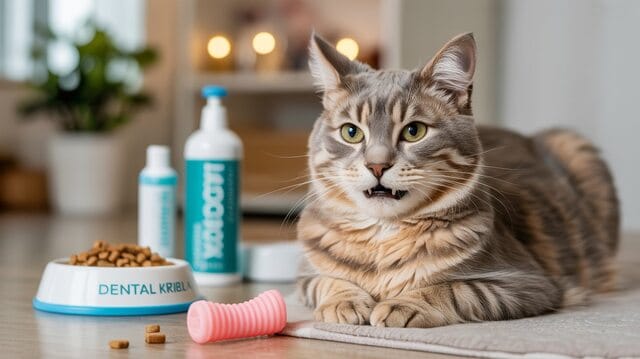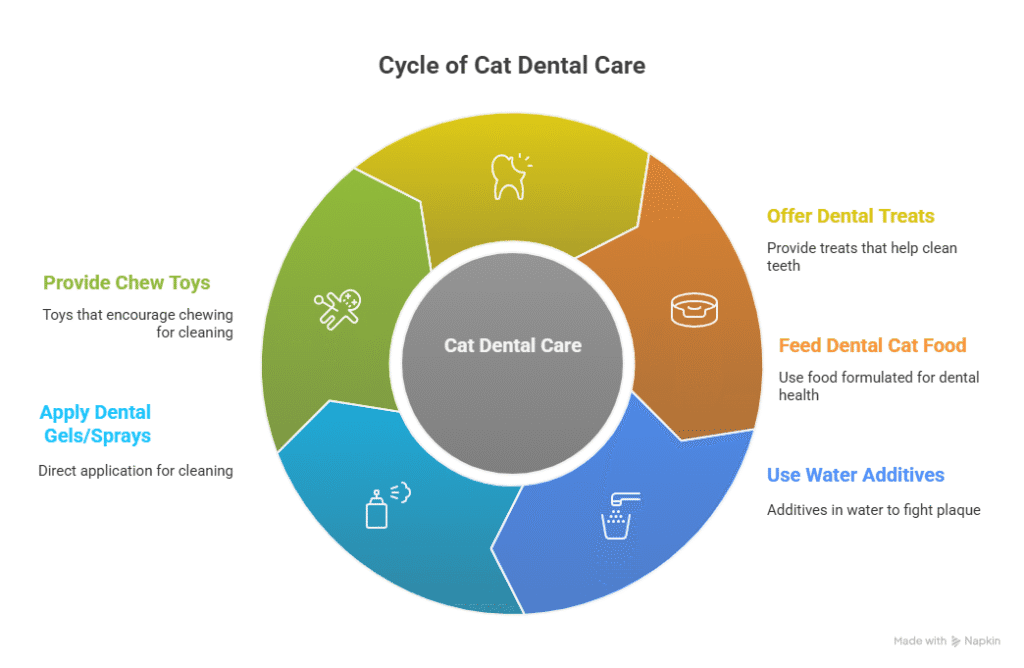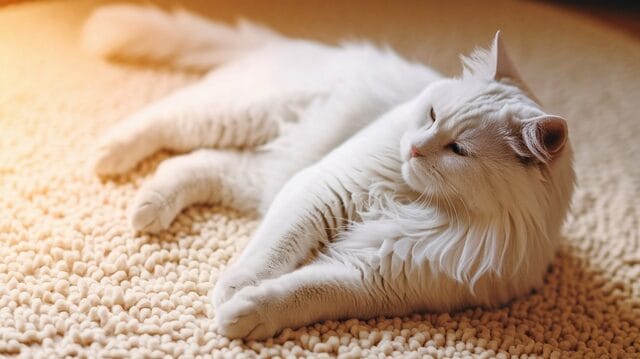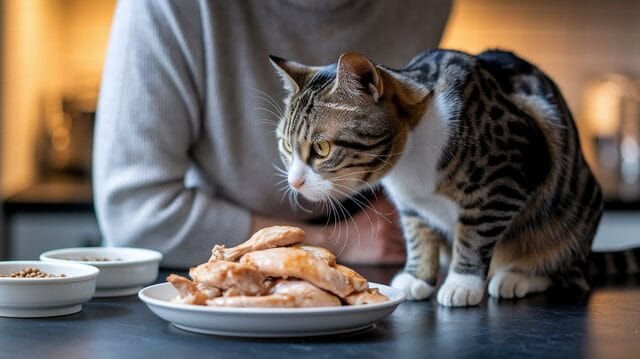
Introduction
Let’s be honest—brushing your cat’s teeth is one of those things that sounds good in theory, but rarely goes according to plan. The moment you even think about prying open your cat’s mouth, it’s game over: squirming, scratching, growling, or full-blown vanishing.
And you end up wondering, How to Keep Your Cat’s Teeth Clean Without Brushing?
If you’ve been there, you’re not alone.
But the good news? You don’t have to brush your cat’s teeth to keep their mouth clean and healthy.
With the right tools, habits, and know-how, it’s entirely possible to manage your cat’s dental hygiene, without a toothbrush showdown.
In this guide, we’ll explore simple, science-backed ways to keep your cat’s teeth clean, reduce plaque and tartar, and promote a healthier mouth—no brushing required.
Why Dental Health Is So Important for Cats
Oral health isn’t just about fresh breath—it’s closely linked to your cat’s overall well-being.
By age 3, over 70% of cats show signs of dental disease, according to the American Veterinary Dental College.
🦷 Poor dental hygiene can lead to:
- Gingivitis (gum inflammation)
- Periodontal disease (damage to tissue and bone)
- Tooth resorption (painful erosion of tooth structure)
- Chronic bad breath
- Pain while eating
- Systemic infections affecting the heart, kidneys, and liver
And the tricky part? Cats are masters at hiding pain.
So your cat might be struggling with mouth discomfort, without showing obvious signs.
Preventive care, even without brushing, can dramatically reduce the risk of serious health problems and keep your feline friend happier, longer.
Signs Your Cat Might Have Dental Problems
Since cats are so good at masking symptoms, it’s important to watch closely for early warning signs of oral trouble:
🚩 Red flags include:
- Bad breath (persistent, not just “fishy”)
- Drooling, especially with blood
- Swollen or bleeding gums
- Difficulty chewing or dropping food
- Pawing at the mouth
- Yellow-brown tartar on teeth
- Avoiding dry kibble
- Sudden preference for soft food
- Decreased appetite or weight loss
If you notice any of these, a vet check is crucial—especially before starting any new home care routine.
How to Keep Your Cat’s Teeth Clean Without Brushing

Let’s dig into the good stuff. These vet-approved alternatives are easier on both you and your cat—and they actually work.
🦴 1. Dental Treats
Dental treats are a tasty and effortless way to help reduce plaque buildup.
✅ What they do:
- Mechanically scrape teeth as your cat chews
- Contain enzymes and ingredients that fight bacteria
- Help freshen breath
- Encourage chewing (a natural cleaning behavior)
Look for products with the VOHC (Veterinary Oral Health Council) Seal, which ensures clinical testing and effectiveness.
Popular options:
- Greenies Feline Dental Treats
- Purina Dentalife
- VetIQ Minties
📝 Note: Treats are not a full replacement for vet care, but they’re a great daily helper.
🥣 2. Dental Cat Food
Yes, there is special food made to clean teeth. These diets use larger kibble that encourages cats to bite and chew more thoroughly, scraping the teeth as they eat.
Some formulas also include:
- Anti-plaque enzymes
- Calcium binders
- Ingredients to reduce bacterial buildup
Great for:
- Cats who graze dry food
- Older cats who won’t tolerate oral care products
- Pet parents who want a “set it and forget it” routine
Examples:
- Hill’s Prescription t/d Dental
- Royal Canin Dental
- Science Diet Oral Care
Ask your vet whether your cat qualifies for a prescription formula, or try an over-the-counter dental kibble as a supplement.
💧 3. Water Additives
Think of these like mouthwash for cats—but tasteless, odorless, and 100% safe to ingest.
Just add a small amount to your cat’s water bowl daily.
Benefits:
- Fight plaque-causing bacteria
- Neutralize odors
- Reduce tartar buildup
- Super easy to use—no handling needed
Popular brands:
- TropiClean Fresh Breath
- Oxyfresh Pet Dental Water Additive
- Dental Fresh for Cats
📝 Tip: Always provide an additional bowl of plain water in case your cat is sensitive to taste changes.
💦 4. Dental Gels and Sprays (No Brushing Required)
These products are applied directly to the teeth or gums—no brushing necessary. They contain enzymes that naturally break down plaque and inhibit bacterial growth.
Some cats will lick it off your finger, while others tolerate a quick swipe on their gum line.
Perks:
- Enzyme-based = natural and effective
- Helps reduce plaque, tartar, and bacteria
- Some formulas come flavored (like poultry or tuna)
To try:
- Vet’s Best Enzymatic Dental Gel
- Oratene Brushless Oral Gel
- TropiClean Oral Care Gel
📝 Start slow. Even one application per week can help!
🧸 5. Dental Chew Toys for Cats
These aren’t just for dogs—cats benefit from chew play too, especially if they’re young, teething, or just love a good gnaw.
Look for:
- Textured rubber or silicone toys
- Infused catnip for interest
- Soft enough to avoid breaking teeth
- Dental-safe materials (BPA-free, non-toxic)
These toys help:
- Stimulate saliva (which protects teeth)
- Gently scrape plaque
- Prevent boredom—another health booster
📝 Rotate toys to keep things fresh and engaging.
Natural Remedies: Do They Work?
You’ll find a lot of DIY suggestions online—some helpful, others questionable.
🍃 Let’s break it down:
✅ Coconut Oil
- Has mild antimicrobial properties
- Can be rubbed on gums in small amounts
- Some cats love the taste
- Safe in moderation
❗ Doesn’t replace vet-approved products
✅ Parsley (as a treat)
- Natural breath freshener
- Safe in small doses
- Chop finely and sprinkle over food
⚠️ Use Caution With:
- Apple cider vinegar
- Baking soda
- Essential oils
These can irritate your cat’s mouth or digestive system and should only be used under veterinary guidance.
What to Avoid Completely
Some well-intended efforts can do more harm than good. Avoid:
❌ Dog toothpaste or dental products
Contain xylitol, fluoride, or other ingredients toxic to cats.
❌ Human toothpaste
Highly dangerous—even in small amounts.
❌ Hard bones or dental sticks made for dogs
Can fracture feline teeth or pose choking hazards.
❌ Over-cleaning without guidance
Too much or too many products at once can upset your cat or cause irritation.
Always introduce new routines slowly and observe your cat’s reaction.
Indoor Cats Need Dental Care Too
There’s a myth that indoor cats don’t need as much oral hygiene, but that’s far from true.
Dental problems in cats are caused by:
- Genetics
- Diet
- Saliva chemistry
- Age
- Lack of dental care
Indoor cats are still prone to plaque, gingivitis, and resorptive lesions. Just because they don’t chew birds and bones doesn’t mean their teeth stay clean on their own.
So whether your cat’s a lazy window watcher or an active explorer, they still need some form of daily dental support.
How Often Should You Use These Alternatives?
- Dental treats: 1–2 per day (follow package instructions)
- Dental kibble: As part of daily meals
- Water additives: Change water daily
- Gels/sprays: 2–3 times per week or as directed
- Chew toys: Available daily, rotate weekly
📝 Consistency is key. Even if you rotate methods, using at least one daily support will make a big difference over time.
When to See a Vet for Professional Cleaning
Even with the best at-home care, some plaque and tartar still accumulate.
That’s when your vet steps in.
A professional dental cleaning is needed if:
- There’s visible tartar or red gums
- Your cat shows signs of mouth pain
- Your cat has never had a cleaning and is over 3
- You’re seeing foul breath or behavioral changes
Vet cleanings are done under anesthesia and involve:
- Scaling and polishing teeth
- Checking for loose or damaged teeth
- Removing infected or resorbed teeth if necessary
📝 Ask your vet during annual exams if a cleaning is recommended based on your cat’s age and condition.
FAQs
Can I use baking soda to clean my cat’s teeth?
No. Baking soda is too alkaline for a cat’s stomach and may cause irritation or vomiting. Use only vet-approved dental products.
Are crunchy foods enough to keep teeth clean?
Not entirely. While kibble helps a bit, it doesn’t replace the need for dental support, especially with soft canned diets or treats.
What’s the best dental product for cats who hate being touched?
Water additives and dental treats are your best bet. They require no physical handling and are accepted by most cats.
How do I introduce dental gel without stress?
Start with a small dab on your finger. Let your cat lick it. Then try gently rubbing it on the gums over a few sessions.
Also Read - Why Does My Cat Bite My Hair? Feline Behavior Explained
Conclusion
Brushing your cat’s teeth might be ideal, but for many cat parents, it’s just not realistic.
Luckily, there are plenty of gentle, effective ways to protect your cat’s oral health without a toothbrush.
From dental treats and toys to water additives and gels, the key is finding what your cat tolerates—and sticking with it consistently.
Healthy teeth mean:
- Less pain
- Fewer vet bills
- Better breath
- A longer, happier life
And best of all? You can keep your cat’s teeth clean without ever risking a scratch or hiss.
Now that’s something to smile about. 😸🦷




